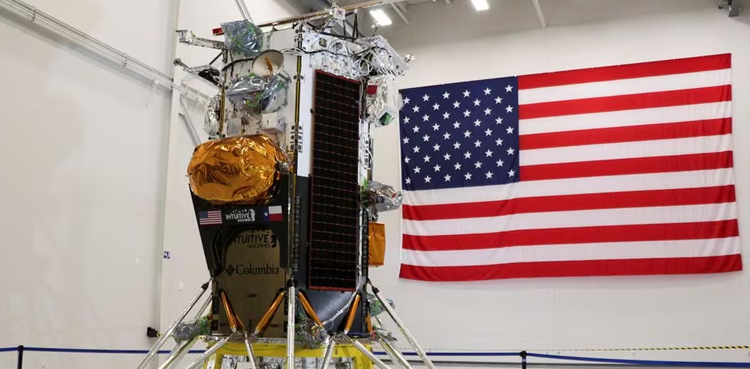
A robotic moon lander built by Houston-based aerospace company Intuitive Machines was set for launch early on Wednesday on a NASA mission to conduct the first US lunar touchdown in more than a half century and the first by a privately owned vehicle.
The company’s Nova-C lander, dubbed Odysseus, was due for liftoff shortly before 1 a.m. EST (0600 GMT) atop a SpaceX Falcon 9 rocket from NASA’s Kennedy Space Center in Cape Canaveral, Florida.
Forecasts called for a 95% chance of favorable weather conditions.
The launch comes a month after the lunar lander of another private firm, Astrobotic Technology, suffered a propulsion system leak on its way to the moon shortly after being placed in orbit on Jan. 8 by a United Launch Alliance (ULA) Vulcan rocket making its debut flight.
The failure of Astrobotic’s Peregrine lander, which was also on a NASA mission, marked the third time a private company had been unable to achieve a “soft landing” on the lunar surface, following ill-fated efforts by companies from Israel and Japan.
Those mishaps illustrate the risks NASA faces in leaning more heavily on the commercial sector than it had in the past to realize its spaceflight goals.
Plans call for Intuitive Machines’ Nova-C vehicle, a hexagonal cylinder with four legs, to reach its destination after about a weeklong flight as early as Feb. 22 for a landing at crater Malapert A near the moon’s south pole.
If successful, the flight, dubbed IM-1, would represent the first controlled descent to the lunar surface by a U.S. spacecraft since the final Apollo crewed moon mission in 1972, and the first by a private company.
The feat also would mark the first journey to the lunar surface under NASA’s Artemis moon program, as the U.S. races to return astronauts to Earth’s natural satellite before China lands its own crewed spacecraft there.
IM-1 is the latest test of NASA’s strategy of paying for the use of spacecraft built and owned by Elon Musk’s SpaceX and other private companies to slash the cost of the Artemis missions, envisioned as precursors to human exploration of Mars.
By contrast, during the Apollo era, NASA bought rockets and other technology from the private sector, but owned and operated them itself.
NASA announced last month that it was delaying its target date for a first crewed Artemis moon landing from 2025 to late 2026, while China has said it was aiming for 2030.
Small landers such as Nova-C are expected to get there first, carrying instruments to gather data about the lunar environment. Odysseus will focus on space weather interactions with the moon’s surface, radio astronomy, precision landing technologies and navigation.
Read more: Japan’s ‘Moon Sniper’ attempts historic lunar landing
Intuitive Machine’s IM-2 mission is scheduled to land at the lunar south pole in 2024, followed by an IM-3 mission later in the year with several small rovers.
Last month, Japan became the fifth country to place a lander on the moon, with its space agency JAXA achieving an unusually precise “pinpoint” touchdown of its SLIM probe last month. Last year, India became the fourth nation to land on the moon, after Russia failed in an attempt the same month.
The United States, the former Soviet Union and China are the only other countries that have carried out successful soft lunar touchdowns. China scored a world first in 2019 by achieving the first landing on the far side of the moon.
https://ift.tt/GbYkM4d
https://ift.tt/U21vAen





0 Comments